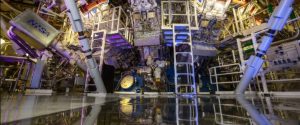Breakthrough In Nuclear Fusion Research:

The Lawrence Livermore National Laboratory in California announced that an experiment carried out in its National Ignition Facility has made a breakthrough in nuclear fusion research.
- In the experiment, lasers were used to heat a small target or fuel pellets. These pellets containing deuterium and tritium fused and produced more energy.
- The team noted that they were able to achieve a yield of more than 1.3 megajoules.
- The megajoule of energy released in the experiment is indeed impressive in fusion terms, but in practice, this is equivalent to the energy required to boil a kettle.”
- Nuclear fusion is defined as the combining of several small nuclei into one large nucleus with the subsequent release of huge amounts of energy.
- Nuclear fusion powers our sun and harnessing this fusion energy could provide an unlimited amount of renewable energy.
- Nuclear fusion energy is a good choice as the baseload energy in the future with many advantages, such as inexhaustibility of resources, inherent safety, no long-lived radioactive wastes, and almost no CO2 emissions.
Nuclear fusion is a reaction in which two or more atomic nuclei are combined to form one or more different atomic nuclei and subatomic particles. The difference in mass between the reactants and products is manifested as either the release or the absorption of energy.




